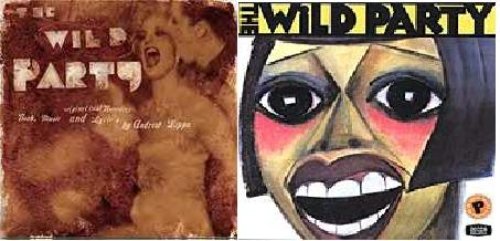“The Wild Party” has had a long history of being both controversial and being ignored. It was originally penned as an epic poem by Joseph Moncure March and was promptly banned for being too sexual.While it still languishes in a relative amount of obscurity, it has managed to exert a decent amount of influence over the literary world, including being the reason why William Burroughs got into writing. Since being published, it has inspired a movie that no one saw, and two musicals that, again, no one saw. The 1999-2000 New York City theater season premiered the opening of both musicals, and both of them closed within three months.
The basic story is that during Prohibition, Queenie is a blond bombshell vaudeville dancer who likes to sleep around. Her current live in boyfriend-thing is Burrs, the clown who goes on before her act. They currently have a passive-aggressive/aggressive/open relationship and are always fighting. They decide to throw a party, and invite all of their frenemies to show up. Topping the list is Kate, Queenie’s best friend, and her man du-jour, Black. Queenie and Black hit it off, much to Kate and Burrs ‘ mutual dissatisfaction. After the party devolves into a drunken orgy, Burrs confronts Queenie with a gun, and Black rushes in and shoots Burrs, just as the cops arrive to break up the party.
Author’s note: I have decided to include a link or two to YouTube videos taken illegally of these shows. I do not wish to condone the taking of such videos. However, I do feel that, like reading Shakespeare, musical theater is an art form that needs the theater setting, and not just a cast recording. The few links I will provide are ones to performances that I feel should not be missed. I hope that this can springboard new fans into finding more about these shows, and helping bring them into communities that wouldn’t be aware of their existence in the first place.
In the theater world, Andrew Lippa, he who wrote the recent Addams Family musical, wrote the better known version. The Lippa “Wild Party” streamlines the show, focusing less on the ensemble and instead focusing on the two couples and their relationships. The race of the characters doesn’t play much of a factor in this version, if at all, which is helped by the out of time setting of the original design. While all the costumes and sets had a “period” feel, they also felt modernized, which is aided by the musical arrangements, which often time have a jazz base, but quickly take on a modern, rock feel.
This is both an asset and a detriment, as many of the songs are incredible character pieces, but unfortunately don’t gel into the show, such as the Act One finale, “What is It About Her?” a piece that has been taken over by ever single leading man who wants to have pathos at an audition, but it’s prettiness takes away from the fact that we’re watching a misogynistic asshole that we’re supposed to hate talk about how no one else is allowed to touch his woman. Though that is a very different take from the Broadway version, where Burrs is played much less sympathetically and is instead played by Mandy Patinkin in his most manic, serial killer mode.
LaChiusa’s Broadway version sticks more to the original poem, including setting up the entire show as one big Vaudeville show, complete with cue cards, where the minor characters glossed over in the Off-Broadway version are given their own character songs and sets. Race had a much bigger place in this show, as Kate, Eddie the prize fighter, and the Brothers D’Armano the gay songwriters, are all black.
Eddie’s story arch revolves around him being black, with a white trophy wife; the Brothers D’Armano sing about the Harlem Renaissance, and Burrs is made into a black-face minstrel, upping the creepy and inappropriate factor, and none of which is in the original poem. The music of LaChiusa’s score matches the setting better, and as a show, despite having fewer break out numbers, is much tighter as a show. It was well received by critics and the few audience members who saw it, who praised the tightness and the well rounded characterizations of the cast, as well as the glittery nature of the music, with the stand out, show stopping, knock out performance award given to Eartha Kitt for “Moving Uptown.”
So, let’s end this party with a clip of the Broadway cast performing at the Tony’s. Yes, that’s Toni Colette, and no, she didn’t suck as hard as this performance did. The problem with many of the Tony performances is that they’re a quickly thrown together piece trying to showcase the entirety of the show in about 4 minutes. Plus, the performers were already in the audience, and have to change and warm up and get ready in a short amount of time. Go check out the cast recordings.
